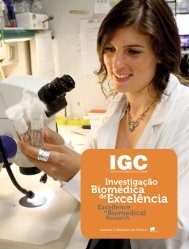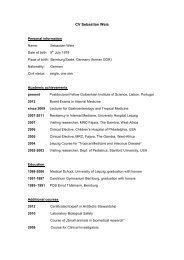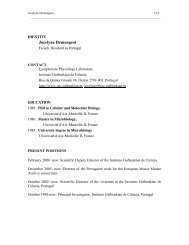organisation - the Instituto Gulbenkian de Ciência
organisation - the Instituto Gulbenkian de Ciência
organisation - the Instituto Gulbenkian de Ciência
- No tags were found...
Create successful ePaper yourself
Turn your PDF publications into a flip-book with our unique Google optimized e-Paper software.
COLLECTIVE<br />
DYNAMICS<br />
Gabriela Gomes Principal Investigator<br />
PhD in Ma<strong>the</strong>matics, University of Warwick, UK, 1993<br />
Post-doctoral Researcher, Ma<strong>the</strong>matics Institute, University of Warwick<br />
Wellcome Trust Research Training Fellow in Ma<strong>the</strong>matical Biology, Department of Biological Sciences, University of Warwick<br />
Principal Investigator at <strong>the</strong> IGC since 2002<br />
We study collective phenomena, such as self-<strong>organisation</strong>, criticality, and pattern<br />
formation, arising from spatial and temporal constraints in physical and<br />
biological systems, with a current focus on infectious disease ecology and evolution.<br />
The central <strong>the</strong>me of our research <strong>de</strong>rives from a conceptual mo<strong>de</strong>l of<br />
partial immunity whose collective outcome - <strong>the</strong> reinfection threshold - un<strong>de</strong>rlies<br />
a phenomenological transition in epi<strong>de</strong>mic dynamics, with practical implications<br />
ranging from extreme geographical variability in <strong>the</strong> effect of vaccination<br />
programmes to <strong>de</strong>stabilised transmission favouring polymorphism in antigenically<br />
diverse pathogens. We are interested in refining concepts and methodologies<br />
by performing specific experiments in <strong>the</strong> laboratory and in natural<br />
populations.<br />
MOLECULAR EPIDEMIOLOGY OF MYCOBACTERIUM TUBERCULOSIS IN PORTUGAL:<br />
IMPLEMENTING AND ANALYSING A DATABASE<br />
We propose to genotype all <strong>the</strong> strains from sputum of smear positive pulmonary<br />
tuberculosis cases with recent methods based on <strong>the</strong> variability of mycobacterial<br />
interspersed repetitive units (MIRU) and variable number tan<strong>de</strong>m<br />
repeats (VNTR). A database that inclu<strong>de</strong>s mycobacterial genotype and clinical<br />
and <strong>de</strong>mographic information about patients will be implemented, constituting<br />
a valuable resource for molecular epi<strong>de</strong>miology studies, transmission mo<strong>de</strong>ls<br />
and applied research on mycobacterial evolution and pathogenesis.<br />
A total of 2286 isolates of M. tuberculosis DNA were genotyped for 90 SNPs.<br />
About 300 strains were genotyped in <strong>the</strong> first year and 743 strains were genotyped<br />
during <strong>the</strong> second year. In <strong>the</strong> last period of <strong>the</strong> project, 1239 more samples<br />
were inclu<strong>de</strong>d. Increasing <strong>the</strong> number of genotyped strains is our immediate<br />
goal and will allow us to infer on <strong>the</strong> genetic diversity of M. tuberculosis<br />
circulating in <strong>the</strong> Portuguese population.<br />
EXPLORING PATHOGEN DIVERSITY IN DISEASE EPIDEMIOLOGY<br />
AND VACCINE RESEARCH<br />
Viruses, bacteria and parasitic pathogens have evolved multiple strategies to<br />
eva<strong>de</strong> innate and acquired immune responses, facilitating transmission, allowing<br />
<strong>the</strong> establishment of persistent and recurrent infections, and often hampering<br />
<strong>the</strong> <strong>de</strong>velopment of effective vaccines. Antigenic variation of immune<br />
response targets is one such pathogen strategy that can only be confronted<br />
with <strong>the</strong> support of a highly specialised research programme combining basic<br />
and applied research. This is <strong>the</strong> <strong>the</strong>me of this project. The team integrates basic<br />
research in infection, population genetics, and ma<strong>the</strong>matical epi<strong>de</strong>miology,<br />
with a range of practical aspects of experimental <strong>de</strong>sign from <strong>the</strong> laboratory<br />
to <strong>the</strong> field. The overall research strategy is to unravel <strong>the</strong> molecular bases and<br />
epi<strong>de</strong>miological significance of immunity in or<strong>de</strong>r to gui<strong>de</strong> vaccine <strong>de</strong>sign and<br />
<strong>de</strong>ployment.<br />
GROUP MEMBERS<br />
João Sollari Lopes (Post-doc, started in April)<br />
Ana Isabel Franco (Post-doc, started in September)<br />
Cátia Ban<strong>de</strong>iras (Trainee, started in December)<br />
Delphine Pessoa (Trainee)<br />
Bruno Ceña (Trainee)<br />
Caetano Souto Maior Men<strong>de</strong>s (Trainee, started in October)<br />
COLLABORATORS<br />
José Pereira-Leal (IGC, Portugal)<br />
Isabel Marques (IGC, Portugal)<br />
Carlos Penha-Gonçalves (IGC, Portugal)<br />
Lounes Chikhi (IGC, Portugal)<br />
Ana Godinho (IGC, Portugal)<br />
Anabela Miranda<br />
(INSA - <strong>Instituto</strong> Nacional <strong>de</strong> Saú<strong>de</strong> Dr. Ricardo Jorge, Portugal)<br />
Ana Abecasis (CMDT-IHMT - <strong>Instituto</strong> <strong>de</strong> Higiene e Medicina Tropical,<br />
Portugal)<br />
Diogo Pinheiro (ISEG - <strong>Instituto</strong> Superior <strong>de</strong> Economia e Gestão, Portugal)<br />
Raquel Sá-Leão (ITQB - <strong>Instituto</strong> <strong>de</strong> Tecnologia Química e Biológica,<br />
Portugal)<br />
Cláudia Co<strong>de</strong>ço (Fundação Oswaldo Cruz, Brazil)<br />
Alessandro Vespignani (Institute for Scientific Interchange, Italy)<br />
Lewi Stone (Tel Aviv University, Israel)<br />
Dirk Brockmann (Max Planck Institute Gottingen, Germany)<br />
Ronald Smallenburg (Grote Griepmeting, The Ne<strong>the</strong>rlands)<br />
John Edmunds (London School of Hygiene and Tropical Medicine, UK)<br />
Olof Nyrén (Swedish Institute for Infectious Disease Control, Swe<strong>de</strong>n)<br />
Marc van Ranst (Rega Institute for Medical Research, Belgium)<br />
Shlomo Havlin (Bar Ilan University, Israel)<br />
Stefano Merler (Fondazione Bruno Kessler, Italy)<br />
Daniele Miorandi (Center for Research and Telecommunication<br />
Experimentation for NETworked communities, Italy)<br />
Mário Silva (Faculda<strong>de</strong> <strong>de</strong> Ciências, Universida<strong>de</strong> <strong>de</strong> Lisboa, Portugal)<br />
Natalia Mantilla (Universidad Nacional Autónoma <strong>de</strong> México, México)<br />
Glória Teixeira (Universida<strong>de</strong> Fe<strong>de</strong>ral da Bahia, Brazil)<br />
FUNDING<br />
Fundação para a Ciência e a Tecnologia (FCT), Portugal<br />
Framework Programme 7, European Commission<br />
We compared key parameters un<strong>de</strong>rlying pneumococcal transmission in Portuguese<br />
and Finnish day care centres using a continuous-time event history mo<strong>de</strong>l<br />
in a Bayesian framework. We <strong>de</strong>veloped ma<strong>the</strong>matical and statistical mo<strong>de</strong>ls to<br />
elucidate <strong>the</strong> <strong>de</strong>sign of novel pre-clinical and clinical trials to assess intervention<br />
efficacy both in <strong>the</strong> laboratory and in <strong>the</strong> field. The new <strong>de</strong>signs are being<br />
refined using Drosophila-Wolbachia as an experimental system.<br />
EPIWORK - DEVELOPING THE FRAMEWORK FOR AN EPIDEMIC FORECAST<br />
INFRASTRUCTURE<br />
In recent years a huge flow of quantitative social, <strong>de</strong>mographic and behavioural<br />
data is becoming available, spurring <strong>the</strong> quest for innovative technologies that<br />
can improve <strong>the</strong> traditional disease-surveillance systems, providing faster and<br />
better localised <strong>de</strong>tection capabilities and resulting in a broad practical impact.<br />
IGC ANNUAL REPORT ‘11<br />
RESEARCH GROUPS<br />
40






